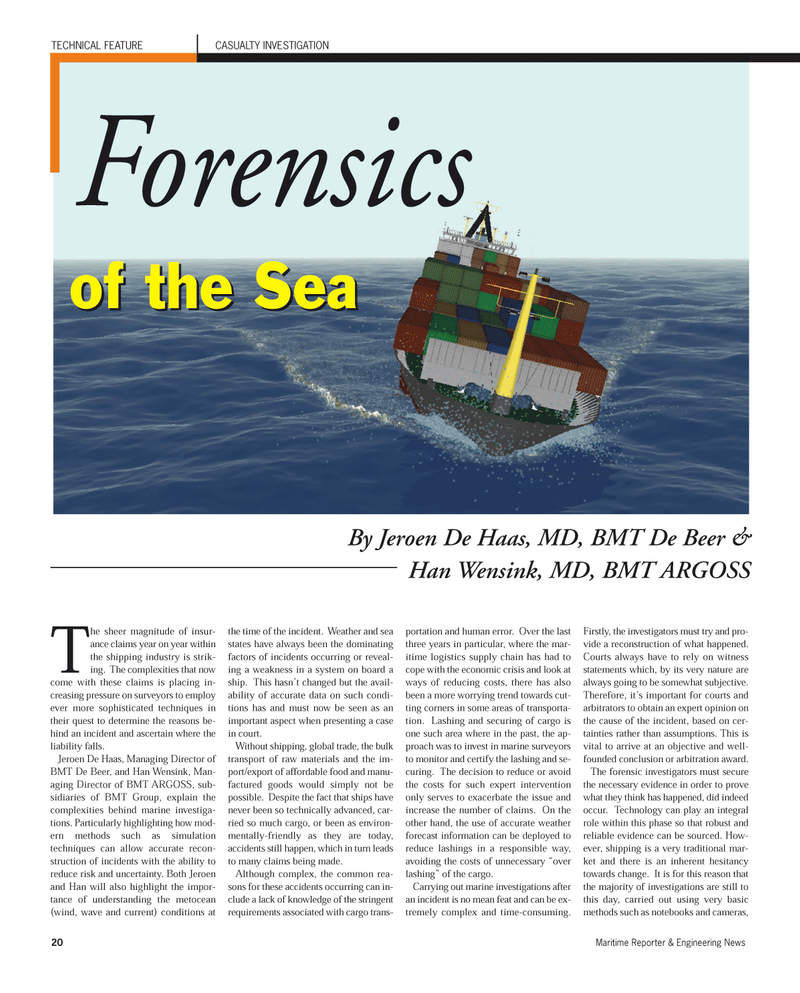
Page 20: of Maritime Reporter Magazine (December 2012)
Great Ships of 2012
Read this page in Pdf, Flash or Html5 edition of December 2012 Maritime Reporter Magazine
20Maritime Reporter & Engineering News The sheer magnitude of insur- ance claims year on year withinthe shipping industry is strik-ing. The complexities that now come with these claims is placing in-creasing pressure on surveyors to employ ever more sophisticated techniques in their quest to determine the reasons be-hind an incident and ascertain where theliability falls. Jeroen De Haas, Managing Director ofBMT De Beer, and Han Wensink, Man- aging Director of BMT ARGOSS, sub- sidiaries of BMT Group, explain the complexities behind marine investiga- tions. Particularly highlighting how mod- ern methods such as simulationtechniques can allow accurate recon- struction of incidents with the ability toreduce risk and uncertainty. Both Jeroen and Han will also highlight the impor- tance of understanding the metocean(wind, wave and current) conditions at the time of the incident. Weather and sea states have always been the dominating factors of incidents occurring or reveal- ing a weakness in a system on board aship. This hasn?t changed but the avail- ability of accurate data on such condi-tions has and must now be seen as an important aspect when presenting a casein court.Without shipping, global trade, the bulk transport of raw materials and the im- port/export of affordable food and manu- factured goods would simply not be possible. Despite the fact that ships have never been so technically advanced, car- ried so much cargo, or been as environ- mentally-friendly as they are today, accidents still happen, which in turn leadsto many claims being made. Although complex, the common rea- sons for these accidents occurring can in-clude a lack of knowledge of the stringent requirements associated with cargo trans- portation and human error. Over the last three years in particular, where the mar- itime logistics supply chain has had tocope with the economic crisis and look atways of reducing costs, there has also been a more worrying trend towards cut- ting corners in some areas of transporta-tion. Lashing and securing of cargo is one such area where in the past, the ap-proach was to invest in marine surveyors to monitor and certify the lashing and se-curing. The decision to reduce or avoid the costs for such expert intervention only serves to exacerbate the issue and increase the number of claims. On theother hand, the use of accurate weatherforecast information can be deployed to reduce lashings in a responsible way, avoiding the costs of unnecessary ?over lashing? of the cargo. Carrying out marine investigations after an incident is no mean feat and can be ex- tremely complex and time-consuming. Firstly, the investigators must try and pro- vide a reconstruction of what happened.Courts always have to rely on witness statements which, by its very nature are always going to be somewhat subjective. Therefore, it?s important for courts and arbitrators to obtain an expert opinion on the cause of the incident, based on cer- tainties rather than assumptions. This is vital to arrive at an objective and well- founded conclusion or arbitration award. The forensic investigators must secure the necessary evidence in order to prove what they think has happened, did indeed occur. Technology can play an integral role within this phase so that robust and reliable evidence can be sourced. How- ever, shipping is a very traditional mar- ket and there is an inherent hesitancy towards change. It is for this reason that the majority of investigations are still to this day, carried out using very basic methods such as notebooks and cameras,TECHNICAL FEATURE CASUALTY INVESTIGATION By Jeroen De Haas, MD, BMT De Beer & Han Wensink, MD, BMT ARGOSS Forensics of the SeaMR#12 (18-25):MR Template 12/3/2012 11:57 AM Page 20

 19
19

 21
21
